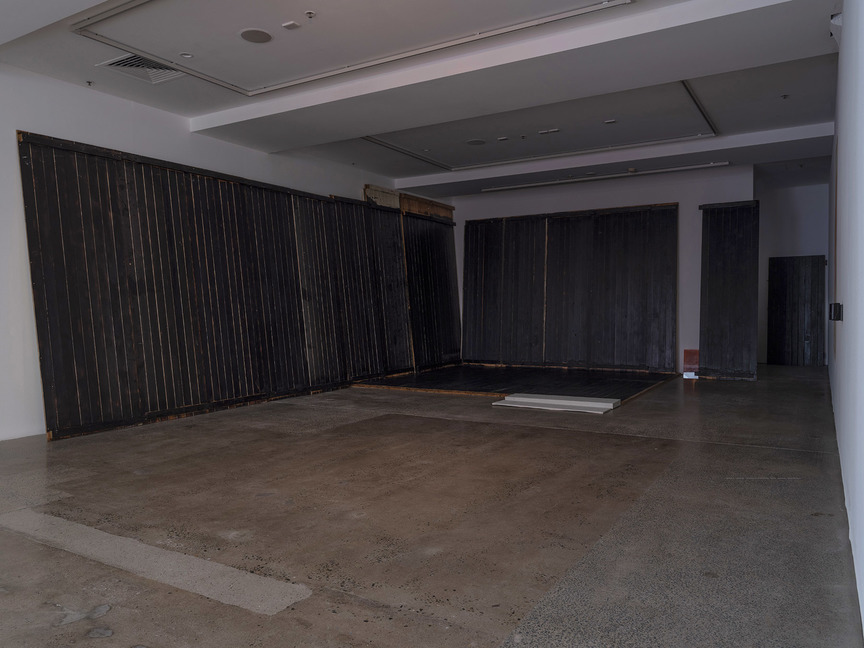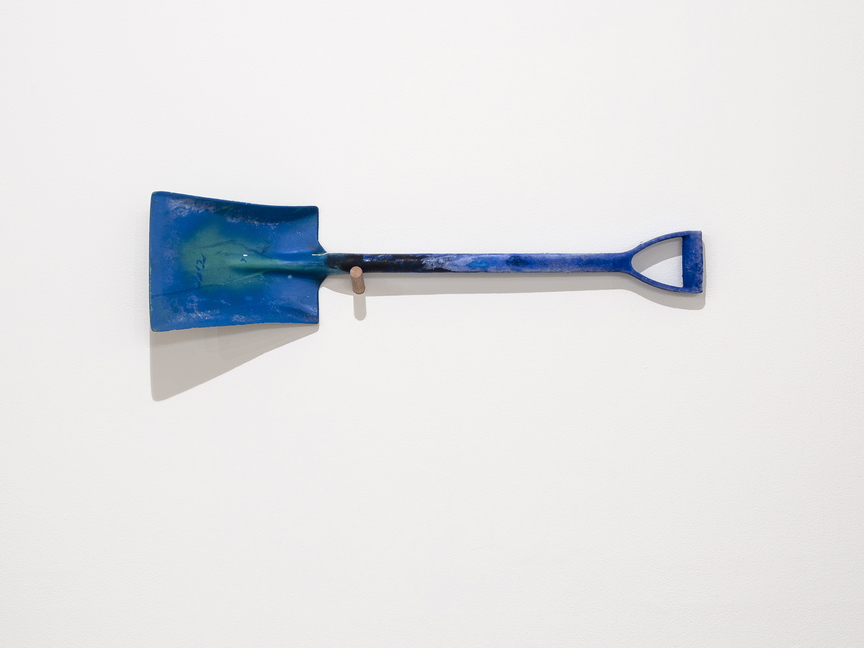-
From Current Issue
-
- Editor’s Letter Fire in the Heart
- Reviews I Gusti Ayu Kadek Murniasih
- Reviews 11th Seoul Mediacity Biennale: “One Escape at a Time”
- Dispatch Networked China
- One on One Monira Al Qadiri on Yukio Mishima
- Essays The rise of independent art spaces in pandemic-era Shanghai
- Features Tuan Andrew Nguyen
- Table of Contents
- Web Exclusives
- Archive
- Subscribe

R
E
V N
E
X
T
Installation view of DALE HARDING’s Body of Objects, 2017, silicone, steel nails, timber, dimensions variable, at “Current Iterations,” Institute of Modern Art, Brisbane, 2019. All photographs taken by Carl Warner. All images courtesy the artist; Milani Gallery, Brisbane; and the Institute of Modern Art, Brisbane.
Dale Harding’s solo exhibition, “Current Iterations,” opened with a view of two rooms. From the entrance, a darkened room with charred timber panels lay ahead. To the right, orange markings danced across a lit room. This interplay of material tensions provided a useful metaphor to frame the show. As lights dim, we shift our reliance on sight toward the other senses. In turn, both our knowledge of place and the mechanisms through which we acquire knowledge change. Harding, who is of the Bidjara, Garingbal and Ghungalu peoples of Queensland, engages with Indigenous Australian histories and living culture in his art, and meditations on place, knowledge and difference coursed throughout his largest exhibition to date.
The darkened section held Perished in isolation (2019), a room-like structure composed of two timber-paneled walls and a floor evoking the popular, domestic architectural style of the “Queenslander.” Shallow plaster steps and a window-like glass pane complete the allusion. Yet the pane is placed close to the ground against the far wall; rather than offering a view out, it disturbingly traps the viewer’s reflection. Perished in isolation is haunted by Harding’s 2015 installation, Their little black slaves, perished in isolation, of a complete house that stands in for a similar structure where, according to senior Ghungalu Elder Uncle Tim Kemp (Harding’s great granduncle), an Indigenous maid, locked in by her employers, died in the flames of a toppled kerosene lamp in 1930. Moving closer to the burnt panels prompted a gentle alarm to sound. On the ground, a pair of discreet texts repeated: “you are welcome to not enter,” marking an invisible boundary across the room. The words mimic the instructional texts of institutional spaces but the vernacular is unfamiliar; polite, yet contradictory.
Orange-ocher stencils of Know them in correct judgement (2017/19) filled the walls of the next room. The stencils recorded one long object in a series of parallel lines that repeated, uniformly, before tumbling and criss-crossing. A second stenciling of two smaller objects followed. These markings were made by Jordan Upkett, Harding’s cousin, who chewed and blew colored clay onto the wall. Standing in front of the stencils recalls their creators and reframes them as traces of a private performance. A vitrine held the indexical objects of these markings: a large ceremonial stick modeled on one owned by Harding’s great-great grandmother, and two shorter sticks used by her sons. The vitrine also held a fourth object: a plain-looking, comb-bound text titled The Oral History of Mr Tim Kemp (one of the sons), recorded by Sue Maytom, whose identity and relation to Kemp is left unstated. Unlike the lively and playful stencilings generated by the traditional objects, the document’s singular recording appears mute, a fact reiterated by the vitrine’s enclosure, preventing access to this history. In this work, Harding reveals the limitations of Western knowledge systems. The written word is made inaccessible and static, while traditional objects enable knowledge that is embodied, tactile, interpersonal and performative.
In the final room, Digging stick (2019) and Studio wall (2019) relocated a shovel and sections of wall from Harding’s studio to the gallery, a maneuver rich with comparisons to Marcel Duchamp’s readymades, Jackson Pollock’s performative paintings, and the removal of traditional items for museological display. Untitled (seven red oxides on glass) (2019) continues the allusions to art history; a set of brown rectangles concurrently evokes the Minimalism of Donald Judd and rejects, by way of delicate fissures, the movement’s commitment to gestalt (wholeness). In the center of the room, a series of plinths at differing heights mapped the undulating landscape of Carnarvon Gorge for Body of Objects (2017). Atop the plinths, waxen copies of Indigenous artefacts, such as boomerangs and ceremonial objects, flop like flaccid phalli, making institutional display systems perverse.
Together, the restaged and re-enacted works at “Current Iterations” presented an investigation of diverse knowledge systems, revealing the deficiencies of institutional approaches and inviting the viewer to experience alternative methods of understanding. This invitation is not, however, without its boundaries. Harding carefully maintained his distance through spatial (an invisible line), temporal (a performance already over) and physical (a glass enclosure) devices. “Current Iterations” responded to our desire for access with an invitation to step back.
Dale Harding’s “Current Iterations” is on view at the Institute of Modern Art, Brisbane, until March 30, 2019.
To read more of ArtAsiaPacific’s articles, visit our Digital Library.


















